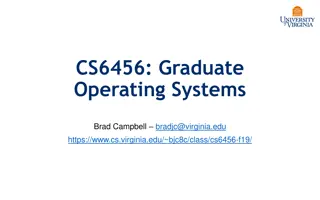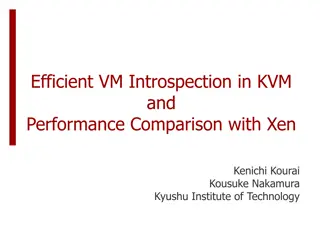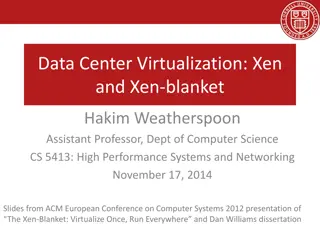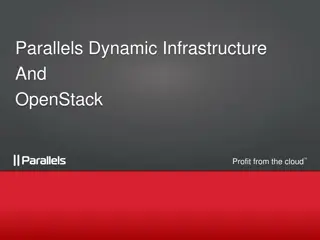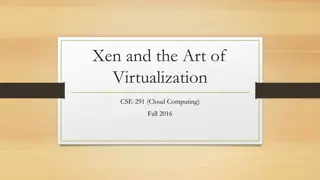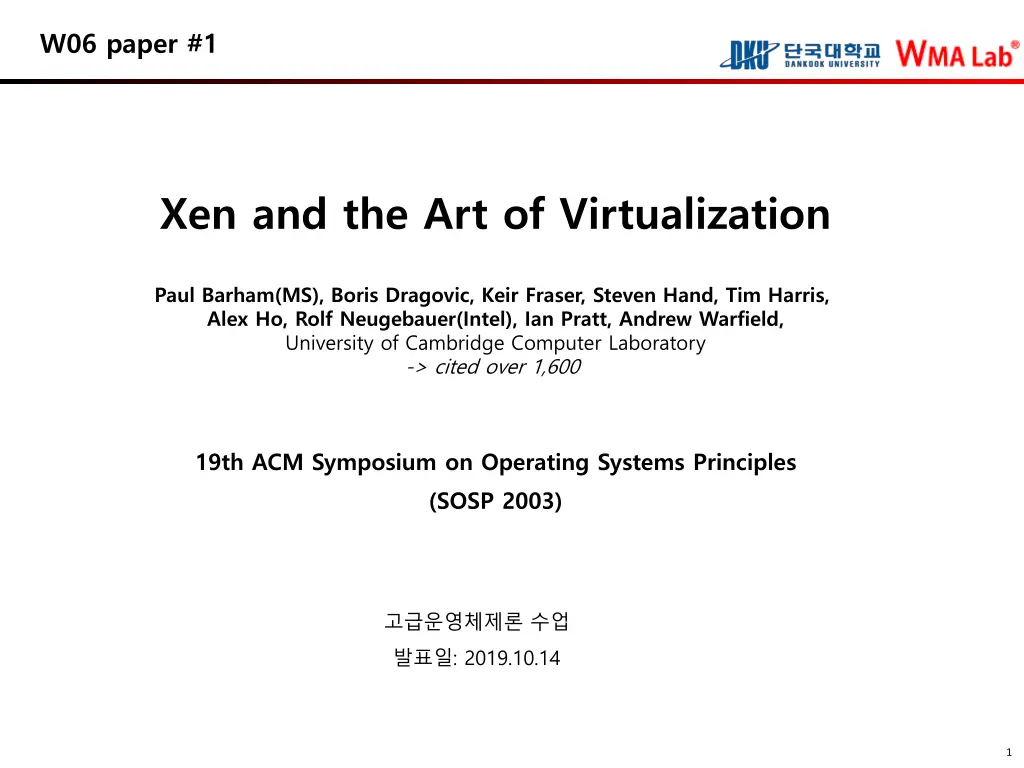
Xen and the Art of Virtualization Overview
Discover the detailed overview of Xen virtualization technology as presented in the 19th ACM Symposium on Operating Systems Principles (SOSP 2003). Explore the benefits, costs, design aspects, and evaluation of Xen, a successful virtualization solution with over 1,600 citations. Learn about the evolution from full virtualization to para-virtualization and the importance of virtualizing architectures.
Download Presentation

Please find below an Image/Link to download the presentation.
The content on the website is provided AS IS for your information and personal use only. It may not be sold, licensed, or shared on other websites without obtaining consent from the author. If you encounter any issues during the download, it is possible that the publisher has removed the file from their server.
You are allowed to download the files provided on this website for personal or commercial use, subject to the condition that they are used lawfully. All files are the property of their respective owners.
The content on the website is provided AS IS for your information and personal use only. It may not be sold, licensed, or shared on other websites without obtaining consent from the author.
E N D
Presentation Transcript
W06 paper #1 Xen and the Art of Virtualization Paul Barham(MS), Boris Dragovic, Keir Fraser, Steven Hand, Tim Harris, Alex Ho, Rolf Neugebauer(Intel), Ian Pratt, Andrew Warfield, University of Cambridge Computer Laboratory -> cited over 1,600 19th ACM Symposium on Operating Systems Principles (SOSP 2003) : 2019.10.14 1
Contents Introduction Virtualization Overview Xen Overview Virtual Machine Interface Cost of Porting Control and Management Xen Design in detail Control transfer: Hypercalls and Events Data transfer: I/O Rings Subsystem Virtualization Binding a New Domain Evaluation Legend Blue pros, goods Red cons, bads Related Works Future Work and Conclusion 2
1. Introduction Why Virtualization? Virtualization in the Enterprise Consolidate under-utilized servers to reduce CapEx and OpEx Avoid downtime with VM Relocation Dynamically re-balance workload to guarantee application SLAs Enforce security policy 3
1. Introduction Full Virtualization Present the illusion of many small Virtual Machines to run multiple instances of different Operating Systems concurrently Virtual Machine exactly like physical machine Pros Can run unmodified OSes in VM Cons Performance Uncooperative hardware Solution: binary rewriting Examples VM/370, VMware, Disco 4
1. Introduction Para-virtualization Present an idealized VM abstraction to guest OSes Differs from underlying hardware interface Pros Can deal with difficulties to virtualize architectures Exposing both a virtual and real interface leads to potential performance enhancements Cons Must port existing OSes to run on paravirtualized host Example Denali (*) this paper was an enhanced version of Denali, but much more successful - citation index of [Xen] is 1600 while [Denali] is 230 Also, [Xen] was successful in terms of commercial impact[Citrix]. 5
1. Introduction Single OS image: Ensim, Vservers, CKRM, Virtuozo, Zones, Docker Group user processes into resource containers Hard to get strong isolation (treated as a process/task) Full virtualization: VMware, VirtualPC, QEMU, VirtualBox Run multiple unmodified guest OSes Hard to efficiently virtualize x86 Para-virtualization: UML, Xen Run multiple guest OSes ported to special arch Arch Xen/x86 is very close to normal x86 6
2. Xen Overview - Features Execution performance is close to native Provides an environment to execute up to 100 VM instances simultaneously Attempts to minimize overhead associated with virtualization Secure isolation between VMs Resource control and QoS Only guest kernel needs to be ported All user-level apps and libraries run unmodified XenoLinux - Port of Linux 2.4 and family OSes(Linux 2.6, NetBSD, FreeBSD, Plan9) XenoXP - Port of Windows XP (in development as of 2003) Supports the same hardware as Linux x86 Live Relocation of VMs between Xen nodes 7
2. Xen Overview - Paravirtualization Xen extensions to x86 arch Like x86, but replaces privileged instructions with Xen hypercalls Avoids binary rewriting Minimize number of privilege transitions into Xen Modifications relatively simple and self-contained For Linux 2.6, only arch-dep files modified (but still needs modification) Modify kernel to understand virtualized env. Wall-clock time vs. virtual processor time Desire both types of alarm timer Expose real resource availability Enables OS to optimize its own behavior MMU virtualization: direct vs. shadow mode 8
2. Xen Overview - I/O Architecture Xen IO-Spaces delegate guest OSes protected access to specified h/w devices Virtual PCI configuration space Virtual interrupts Devices are virtualized and exported to other VMs via Device Channels Safe asynchronous shared memory transport Backend drivers export to frontend drivers Net: use normal bridging, routing, iptables Block: export any blk dev e.g. sda4,loop0,vg3 9
2. Xen Overview - Architecture (2.0) VM0 VM1 VM2 VM3 Device Manager & Control s/w Unmodified User Software Unmodified User Software Unmodified User Software GuestOS (XenoLinux) GuestOS (XenoLinux) GuestOS (XenoXP) GuestOS (XenoBSD) Back-End Back-End Native Device Driver Native Device Driver Front-End Device Drivers Front-End Device Drivers Virtual CPU Virtual MMU Control IF Safe HW IF Xen Virtual Machine Monitor Event Channel Hardware (SMP, MMU, physical memory, Ethernet, SCSI/IDE) 11
2.1 Xen Overview Virtual Machine Interface CPU Memory Device I/O 12
2.1 Xen Overview Virtualized CPU CPU Execution Non-Privileged Instructions can run directly on bare hardware (AKA. bare metal) Privileged operations must be marshaled by Xen Privilege Levels x86 has four privileged levels (rings) 0-3 (0=more 3=less) Xen runs at ring0, Guest OS at ring1, apps at ring3 Exception Handling Guest provides virtual IDT Most ISRs same as on real x86 hardware, page-fault is special case Interrupts and Events Handled via event channels, Xen upcalls into guest Maskable, analogous to disabling interrupts Fast exception handler for Guest OS system-calls 13
2.1 Xen Overview Memory Management Page Tables Guests responsible for managing their own page tables Updates to page tables must go through Xen, and can be batched Page frames contain reference count and type Translation Lookaside Buffer x86 s hardware managed TLB complicates virtualization Xen mapped to the top 64MB of each address space, saves TLB flushes Segmentation Physical Memory Handled in a similar manner as page tables Most Operating Systems expect contiguous memory addresses Illusion of contiguous physical memory provided by physical hardware map Exposing both hardware and physical memory addresses provides area for optimization 14
2.1/3.3 MMU Virtualization : Shadow-Mode guest reads Virtual Pseudo-physical guest writes Guest OS Accessed & dirty bits Updates Virtual Machine VMM Hardware MMU 15
2.1 Xen Overview Device I/O Xen exposes a set of clean and simple device abstractions I/O data transferred between guest and Xen via aync I/O Rings Network Device VFR - Virtual Firewall-Router VIF - Virtual Network Interface Disks VBD - Virtual Block Devices Cache locality 16
2.2 Xen Overview The Cost of Porting an OS Porting an OS to Xen Only architecture-dependent part is modified Porting Linux is rather simple due to virtual I/O drivers Porting WinXP is rather complex, including architecture independent parts, PTEs, legacy 16bit support codes. 17
2.3 Xen Overview Control & Management Domain0 Created at Xen boot-time Has access to Xen s control interface Hosts application-level management software Provides separation of policy and mechanism Control Transfer Hypercalls (rather than system calls which are slow) Events - Lightweight notification 18
2.3 Xen Overview Control & Management Data Transfer I/O Rings Mechanism to allow efficient moving of data vertically through system Based around two pairs of producer-consumer pointers 19
4. Evaluation Compare Linux to different Virtualization tecnhiques XenoLinux compared against Linux, VMWare, User-Mode Linux Benchmarks SPEC: CPU intensive Linux build: 7% of time spent in kernel OSDB-IR/OLTP: OS intensive, many domain transitions (many page faults?) Dbench: filesystem intensive SPEC WEB99: good overall measure 20
4.1 Evaluation - System Performance 1.1 1.0 0.9 0.8 0.7 0.6 0.5 0.4 0.3 0.2 0.1 0.0 L X V U L X V U L X V U L X V U SPEC INT2000 (score) Linux build time (s) OSDB-OLTP (tup/s) SPEC WEB99 (score) Benchmark suite running on Linux (L), Xen (X), VMware Workstation (V), and UML (U) 21
4.2 Evaluation - Network Performance Smaller packet size shows performance degradation due to header overhead 1.1 1.0 0.9 0.8 0.7 0.6 0.5 0.4 0.3 0.2 0.1 0.0 L X V U L X V U L X V U L X V U Tx, MTU 1500 (Mbps) TCP bandwidth on Linux (L), Xen (X), VMWare Workstation (V), and UML (U) Rx, MTU 1500 (Mbps) Tx, MTU 500 (Mbps) Rx, MTU 500 (Mbps) 22
4.3/4.5 Evaluation Concurrent VMs, Scalability Run up to 100 VMs concurrently Only a loss of 7.5% throughput compared to Linux 1000 800 600 400 200 0 L X L X L X L X 2 4 8 16 Simultaneous SPEC WEB99 Instances on Linux (L) and Xen(X) 23
Scalability Scalability principally limited by Application resource requirements Several 10 s of VMs on server-class machines Balloon driver used to control domain memory usage by returning pages to Xen Normal OS paging mechanisms can deflate quiescent domains to <4MB Xen per-guest memory usage <32KB Additional multiplexing overhead negligible 24
6.2 Conclusions Xen provides excellent platform for deploying a wide variety of differing applications Xen provides necessary protection and performance isolation Paravirtualization provides near native performance Xen is a complete and robust GPL VMM http://xensource.com http://xen.sf.net http://www.xen.org 25
7. References [43] A. Whitaker, M. Shaw, and S. D. Gribble. Denali: Lightweight Virtual Machines for Distributed and Networked Applications. Technical Report 02-02-01, University of Washington, 2002. -> Denali [3] G. Banga, P. Druschel, and J. C. Mogul. Resource containers: A new facility for resource management in server systems. In Proceedings of OSDI 1999, pages 45 58, Feb. 1999. [32] S. Oikawa and R. Rajkumar. Portable RK A portable resource kernel for guaranteed and enforced timing behavior. In Proceedings of the IEEE Real Time Technology and Applications Symposium, pages111 120, June 1999 [23] M. F. Kaashoek and et al. Application performance and flexibility on Exokernel systems. In Proceedings of the 16th ACM SIGOPS, vol 31(5) of ACM OS Review, pages 52 65, Oct. 1997. -> Exokernel lightweight resource switching https://www.citrix.com/blogs/2016/08/24/10-years-of-xenserver/ Written 10 years after first release of XenEnterprise 3.0 based on Xen hypervisor 3.0.0 at 2006 https://www.cnet.com/news/citrix-to-buy-virtualization-company-xensource-for-500-million/ Citrix acquired XenSource at $500 mil. in 2007 3 major player: Citrix combination of young blood and old money market darling VMware the (potential) threat of Microsoft's Viridian(Hyper-V) 26
Fun Part The title The Art of of this paper might come from The Art of Computer Programming by Donald E. Knuth, 1968 .. and this book is still being cited 27

